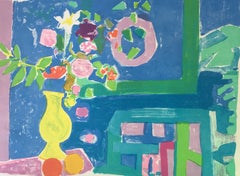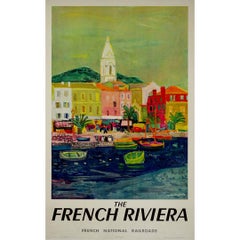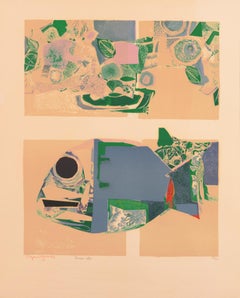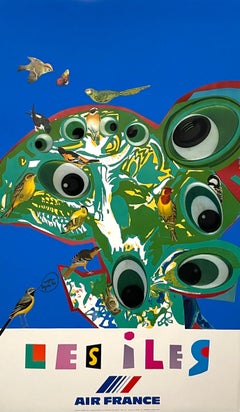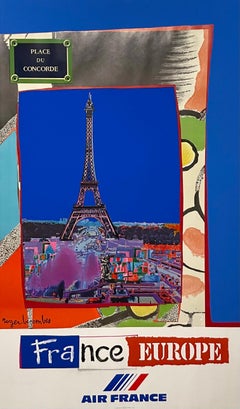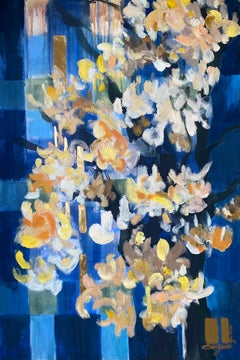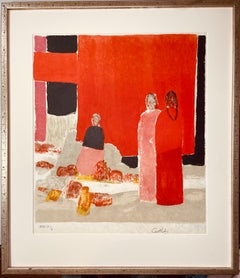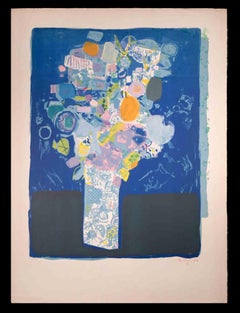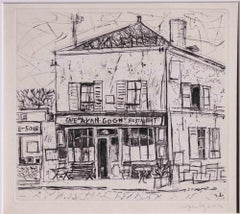Roger Bezombes Art
French, 1913-1994
Roger Bezombes (1913 - 1994) was a French painter, sculptor, medallist and designer. He studied in Paris at the Ecole des Beaux-Arts, and was much influenced by his friendship with Maurice Denis. He worked principally as a painter, adopting the saturated colours of Henri Matisse in landscapes and figure studies often based on observation of 'exotic' cultures, notably Mediterranean and North African. In the mid-1960s a new rawness emerged in his work, derived from 'primitive' examples and new materials associated with his experiments in other media. He executed tapestry designs for Aubusson, posters (winning the Grand Prix de l'Affiche Francaise in 1984), costumes and sets for ballets at the Metropolitan Opera House in New York, reliefs and murals. In 1965 he took up medal-making, expressing in his numerous metallic works for the Paris Mint that obsession with found objects which is also evident in his large-scale sculpture and in his posters.to
3
1
5
11
Overall Width
to
Overall Height
to
17
4
1
10
7
2
1
1
1
1
15
2
5
3
3
3
2
2
1
1
1
1
1
1
1
1
1
1
1
1
1
1
15
5
2
1
1
20
8,777
2,809
1,643
1,319
1
2
13
4
Artist: Roger Bezombes
Approuve' par l'artiste
By Roger Bezombes
Located in Belgrade, MT
This lithograph is part of my private collection. It is limited in edition artist pencil signed lower right and is in very good condition. Roger Bezombes a print maker born in Paris ...
Category
Mid-20th Century Abstract Expressionist Roger Bezombes Art
Materials
Lithograph
$240 Sale Price
29% Off
1956 original poster - The French Riviera French National Railroads SNCF
By Roger Bezombes
Located in PARIS, FR
Step into the sun-drenched world of the French Riviera through the lens of Roger Bezombes' enchanting 1956 poster, a radiant masterpiece created for the French National Railroads (SN...
Category
1950s Roger Bezombes Art
Materials
Lithograph, Paper, Linen
'Blue Fish', Musee National d'Art Moderne, Grand Prix de Rome, Salon d'Automne
By Roger Bezombes
Located in Santa Cruz, CA
Signed lower left, 'Roger Bezombes' (French, 1913-1994) and titled, 'Poisson bleu' with number and limitation, lower right, '25/150'.
Roger Bezombes first attended the Ècole des Beaux-Arts (1934) and was the recipient of numerous prizes, medals and juried awards including the Grand Prix de Rome...
Category
1970s Modern Roger Bezombes Art
Materials
Paper, Lithograph
Air France, Mediterranee by Roger Bezombes
By Roger Bezombes
Located in New York, NY
This lithographic poster was printed in 1981 at the Atelier Mourlot in Paris.
In the early 1970s, Air France commissioned Roger Bezombes to create original artworks capturing the s...
Category
1980s Modern Roger Bezombes Art
Materials
Lithograph
French Modernist Mourlot Lithograph Vintage Air France Poster Roger Bezombes
By Roger Bezombes
Located in Surfside, FL
Vintage French Travel Poster, Air France
Roger Bezombes
(1913-1994) French
Bezombes was a painter, sculptor, medalist, and designer. He studied in Paris, at the École des Beaux-Arts...
Category
1980s Modern Roger Bezombes Art
Materials
Lithograph, Offset
French Modernist Mourlot Lithograph Vintage Air France Poster Roger Bezombes
By Roger Bezombes
Located in Surfside, FL
Vintage French Travel Poster, Air france
Roger Bezombes
(1913-1994) French
Bezombes was a painter, sculptor, medalist, and designer. He studied in Paris, at the École des Beaux-Arts...
Category
1980s Modern Roger Bezombes Art
Materials
Lithograph, Offset
French Modernist Mourlot Lithograph Vintage Air France Poster Roger Bezombes
By Roger Bezombes
Located in Surfside, FL
Vintage French Travel Poster, Air france
Roger Bezombes
(1913-1994) French
Bezombes was a painter, sculptor, medalist, and designer. He studied in Paris, at the École des Beaux-Arts...
Category
1980s Modern Roger Bezombes Art
Materials
Lithograph
Roger Bezombes La Cafetiere Bleue Lithograph
By Roger Bezombes
Located in San Francisco, CA
Roger Bezombes: 1913-1994. Well listed French artist with auction prices for lithographs over $2000. This fantastically colorful still life is pencil si...
Category
1950s Roger Bezombes Art
Materials
Lithograph
1981 Original poster by Roger Bezombes - Air France - Aviation - Gastronomy
By Roger Bezombes
Located in PARIS, FR
Original poster by Roger Bezombes for Air France and gastronomy.
In the early 1980s, Air France asked Roger Bezombes, famous for his sculptures and paintings, to create original artworks illustrating the spirit of Air France. He created a series of 16 colorful photographic collages that were printed at the Atelier Mourlot. These graphic works were created using lithography, typography and embossing with metallic inks.
These posters are revolutionary. Inspired by surrealism, they represent concepts rather than destinations and evoke the mysteries and joys of air travel. Very much ahead of their time, they were only distributed by Air France and exhibited for the first time at the Pompidou Museum of Modern Art ten years after...
Category
1980s Surrealist Roger Bezombes Art
Materials
Lithograph, Paper
Liberte (Liberty) by Roger Bezombes
By Roger Bezombes
Located in New York, NY
This lithographic poster was printed in 1981 at the Atelier Mourlot in Paris.
In the early 1970s, Air France commissioned Roger Bezombes to create original artworks capturing the s...
Category
1980s Modern Roger Bezombes Art
Materials
Lithograph
Riviera - Cote d'Azur Frankreich original vintage travel poster
By Roger Bezombes
Located in Spokane, WA
Original vintage travel poster to the French Riveria, the Cote D'Azur. Linen-backed lithograph created by the artist Roger Bezombes, for the French National Railways. A small Fr...
Category
1950s Impressionist Roger Bezombes Art
Materials
Lithograph
$716 Sale Price
20% Off
1981 Original poster by Roger Bezombes - Air France - Aviation - Liberty
By Roger Bezombes
Located in PARIS, FR
In the early 1980s, Air France commissioned Roger Bezombes, famous for his sculptures and paintings, to create original artworks capturing Air France’s spirit. He produced a series of 16 colorful photo collages that were printed at Atelier Mourlot. These graphic works were executed using lithography, typography, and embossing with metallic inks.
These posters were revolutionary. Inspired by surrealism, they depict concepts rather than destinations and evoke the mysteries and joys of air travel. Far ahead of their time, they were only released by Air France and exhibited for the first time at the Pompidou Museum of Modern Art ten years after...
Category
1980s Surrealist Roger Bezombes Art
Materials
Paper, Lithograph
Original 1959 poster for the Floralies Internationales de Paris
By Roger Bezombes
Located in PARIS, FR
The original 1959 poster for the Floralies Internationales de Paris, designed by Roger Bezombes, is a work of art that skilfully blends the beauty of flowe...
Category
1950s Roger Bezombes Art
Materials
Paper
Air France, Gastronomie by Roger Bezombes, 1981
By Roger Bezombes
Located in New York, NY
Artist: Roger Bezombes
Medium: Lithographic Poster, 1981
Dimensions: 39.5 x 23.75 in, 100.3 x 60.33 cm
Glossy Poster Paper - Condition A- (a few minor creases on some posters due ...
Category
1980s Roger Bezombes Art
Materials
Lithograph
Air France, Mignonne allons voir la Rose by Roger Bezombes
By Roger Bezombes
Located in New York, NY
This lithographic poster was printed in 1981 at the Atelier Mourlot in Paris.
In the early 1970s, Air France commissioned Roger Bezombes to create original artworks capturing the s...
Category
1980s Modern Roger Bezombes Art
Materials
Lithograph
Liberte, Pop Art Screenprint by Roger Bezombes
By Roger Bezombes
Located in Long Island City, NY
Artist: Roger Bezombes, French (1913 - 1994)
Title: Liberte
Year: 1986
Medium: Serigraph, signed and numbered in pencil
Edition: 225
Image Size: 25.5 x 17 inches
Size: 30 x 21.5 in...
Category
1980s Pop Art Roger Bezombes Art
Materials
Screen
Roger Bezombes-Mutation-Original lithograph
By Roger Bezombes
Located in Brooklyn, NY
Roger Bezombes-Mutation-24" x 31.5"-Lithograph-1986-Contemporary-Blue, Red, White-france, french
Category
20th Century Contemporary Roger Bezombes Art
Materials
Lithograph
$220 Sale Price
20% Off
Related Items
Hand painted Artist Proof-Magnolias-Weaver Series-British Awarded Artist #2 of 3
Located in London, GB
This stunning Artist's Proof is an one-off, oil hand-painted and gilded by the artist , signed at front and on the back label too; each proof is 80% hand painted and gold gilded by S...
Category
2010s Abstract Expressionist Roger Bezombes Art
Materials
Gold Leaf
$527
H 47.25 in W 31.5 in D 0.04 in
"Les Mexicaines" / "Mexicans"
By Bernard Cathelin
Located in Berlin, MD
Bernard Cathelin (French 1919-2004) "Les Mexicaines" Colored Lithograph on Rice Paper.
A peaceful impressionistic scene of three Mexican women in the street.
Red. Orange. Black. W...
Category
Late 20th Century Abstract Impressionist Roger Bezombes Art
Materials
Rice Paper, Lithograph
Judy Chicago poster (Hand signed and inscribed) feminist art
By Judy Chicago
Located in New York, NY
Accidents, Injuries and other Calamities poster
Judy Chicago (Hand signed and inscribed), 1988
Offset lithograph on thin board (signed and inscribed by Judy Chicago)
26 × 20 1/4 inch...
Category
1980s Feminist Roger Bezombes Art
Materials
Lithograph, Offset, Pencil
$900
H 26 in W 20.25 in
"CONGREGATION OF WITS: BOX SET", 41 silkscreen prints, double-sided, custom box
By Andrew Cornell Robinson
Located in Toronto, Ontario
"CONGREGATION OF WITS, Box Set of 41 Prints", 2018, limited-edition collection of 40 double-sided silkscreen prints, plus one title print, by Andrew Cornell Robinson. There are 10 box sets in custom-made chocolate linen archival boxes with a gold stamped title. Each print is signed, stamped and editioned. The prints measure 17x17", the box 17.5x17.5".
Note the double-sided printing – surfaces of text, surfaces of image. The installation (see photos above) is a striking performance in itself with myriad possibilities for color, pattern, language, culture, politics, identity. The artist is pleased to offer guidance on the installation, according to the collector's wishes. Or a collector may arrange personally. It's a dynamic body of work that delights in the craft of making and the experience of revealing a tapestry of image and language.
Initially inspired by a visit to the Talking Sculptures...
Category
21st Century and Contemporary Contemporary Roger Bezombes Art
Materials
Paper, Archival Paper, Color, Screen, Linen
Serene Cove Waters, Feng Shui Seascape, Blue and White Ripples, Horizontal Print
By Kind of Cyan
Located in Barcelona, ES
This is an exclusive handprinted limited edition cyanotype.
"Serene Cove Waters" is a handmade cyanotype print portraying fresh ripples movements in a Greek Islands cove...
Category
2010s Abstract Roger Bezombes Art
Materials
Emulsion, Mixed Media, Watercolor, Photographic Paper, Lithograph, Monop...
La Pique (The Pike)
By Pablo Picasso
Located in Fairlawn, OH
La Pique (The Pike)
Lithograph, 1950
Original lithograph drawn with chalk and "frottage textures" transferred to stone, 1950.
Unsigned printer's proof
Inscribed on the verso in Mourl...
Category
1950s French School Roger Bezombes Art
Materials
Lithograph
The End of the Game Rare 1970s ICP print (Hand Signed, inscribed by Peter Beard)
By Peter Beard
Located in New York, NY
Peter Beard
The End of the Game (Hand Signed by Peter Beard), 1977
Offset Lithograph Poster (hand signed by Peter Beard and inscribed with a heart)
Han...
Category
1970s Contemporary Roger Bezombes Art
Materials
Lithograph, Offset
$2,000
H 27.5 in W 20.5 in
Paris Review Poster
By Robert Rauschenberg
Located in New York, NY
A very good impression of this early color offset lithograph on white wove paper. Signed, dated and numbered 8/150 in felt-tip pen and black ink by Rauschenberg...
Category
1960s Modern Roger Bezombes Art
Materials
Color, Lithograph, Offset
Beatles Yellow Submarine Pop Art Poster, Peter Max
By Peter Max
Located in London, GB
Beatles Yellow Submarine
Movie poster after Peter Max
Peter Max is a German-American artist known for his colourful, psychedelic pop art, whi...
Category
1960s Contemporary Roger Bezombes Art
Materials
Lithograph, Linen
Apple, Lt Ed St. Louis Art museum print Signed & dated by Roy Lichtenstein Frame
By Roy Lichtenstein
Located in New York, NY
Roy Lichtenstein 1970-1980 (Hand Signed and dated by Roy Lichtenstein), 1981
Offset lithograph. Hand signed and dated in ink
Hand-signed by artist, H...
Category
1980s Pop Art Roger Bezombes Art
Materials
Ink, Lithograph, Offset, Pencil, Graphite
$8,800
H 37 in W 27 in D 0.5 in
Large Abstract Expressionist Color Monotype, Oil Painting Tom Lieber
By Tom Lieber
Located in Surfside, FL
Tom Alan Lieber, (American, born 1949),
GTW #11 -7, 1986,
Oil and mixed media on paper,
30.25 x 44 inches,
Hand signed and dated lower right
Provenance: Garner Tullis Workshop, ...
Category
1980s Abstract Expressionist Roger Bezombes Art
Materials
Mixed Media, Oil, Monotype
$4,500
H 30.25 in W 44 in
Martin Kippenberger Self-Portraits, rare poster designed by Christopher Wool
By Christopher Wool
Located in New York, NY
Christopher Wool
Martin Kippenberger Self-Portraits Poster, 2005
Offset lithographic poster in colours on smooth wove paper.
36 × 24 inches
Published by Luhring Augustine
Unframed
T...
Category
Early 2000s Minimalist Roger Bezombes Art
Materials
Lithograph, Offset
Previously Available Items
The Flower Vase - Lithograph By Roger Bezombes - 1970s
By Roger Bezombes
Located in Roma, IT
The Flower Vase is a lithograph print realized by Roger Bezombes.
Hand-signed on the lower.
Numbered. Edition, 132/175.
Good Conditions.
Category
1970s Modern Roger Bezombes Art
Materials
Lithograph
H 29.93 in W 22.05 in D 0.08 in
Café Van Gogh Restaurant - Etching By Roger Bezombes -Mid-20th Century
By Roger Bezombes
Located in Roma, IT
Café Van Gogh Restaurant à Auvers-sur-Oise is an original artwork realized by Roger Bezombes in the half of 20th Century.
Black and white etching.
Hand signed and signed on plate. ...
Category
Mid-20th Century Modern Roger Bezombes Art
Materials
Etching
H 12.6 in W 19.3 in D 0.08 in
French Modernist Mourlot Lithograph Vintage Air France Poster Roger Bezombes
By Roger Bezombes
Located in Surfside, FL
Vintage French Travel Poster, Air france
Roger Bezombes
(1913-1994) French
Bezombes was a painter, sculptor, medalist, and designer. He studied in Paris, at the École des Beaux-Arts, and was much influenced by his friendship with Maurice Denis. Heavily influenced by surrealism, He worked principally as a painter, adopting the saturated Fauvist colors of Henri Matisse in landscapes and figure studies often based on observation of “exotic” cultures, notably Mediterranean and North African. Constrained, because a very young orphan, to all kinds of professions which provide him with the material means to devote himself to painting - he participated in 1930 in the installation of the exhibition of the Bauhaus at the Grand Palais-, Roger Bezombes is student of the National School of Fine Arts in Paris. (Ecole des Beaux Artes) He was trained in the art of fresco by Paul Baudoüin, René Barotte nonetheless restores that the young man's preference goes to the practice of "truancy" which he uses to make copies at the Louvre Museum. It’s the time when Paul Gauguin’s paintings, Vincent Van Gogh and Henri Matisse are revealed to him by Maurice Denis with whom he will remain close until his accidental death, painting him on his funeral bed on November 14, 1943. He executed surrealist tapestry designs for Aubusson and Gobelin tapestries, posters (winning the Grand Prix de l'Affiche Francaise in 1984), costumes and sets for ballets at the Metropolitan Opera House in New York, reliefs and murals. In 1965 he took up medal-making, expressing in his numerous metallic works for the Paris Mint that obsession with found objects which is also evident in his large-scale sculpture and in his posters.
He designed posters for Air France and for the French national railways.
Roger Bezombes went to Africa for the first time in 1936 thanks to a travel grant and received the same year the second grand prize of Rome . In 1937 he traveled around Morocco where he became friends with Albert Camus. The year 1938 offered him both his first solo exhibition at the Charpentier gallery in Paris with paintings and gouaches on the theme of Morocco and the attribution of the national grand prize for the arts, earning him a great journey which , from Dakar to Algiers , takes it through Chad , Tamanrasset and Hoggar.
Roger Bezombes became a professor at the Julian Academy in 1950. For him, 1951 was the year of a trip to Greece and the year where he began his relationship with tapestry work.
Roger Bezombes visited Israel in 1953, Tunisia and Egypt in 1954. He was appointed official painter of the Navy in 1955. Pierre Mazars analyzes that “after a period where we notice the influence of Van Gogh and GeorgesBraque, particularly in his landscapes of Provence, he came to a more schematic writing, the colored spots and the thicknesses of material taking more of importance as the subject. He even performed composite works, half-watercolors, half-pasted papers, in which he incorporated pieces of newspapers”. He was elected titular to the Academy of Overseas Sciences in 1978. "The range of Bezombes' talent forms is remarkable,” writes Lynne Thornton, “ranging from paintings, murals, travel posters, tapestry cartons, book illustrations, monumental ceramic decorations, ballet and theater sets, totem sculptures, sculpture objects, jewelry and medallions”. He was part of the mid century mod School of Paris that included Leon Zack, Bernard Lorjou, Paul Augustin Aizpiri, Gabriel Godard, Michel Henry, Hans Erni, Bengt Lindstrom, Alfred Manessier, Andre Hambourg, Raymond Legueult and Jean Rigaud.
Select Solo Exhibitions:
1938: Galerie Charpentier, Paris
1950, '53, '55, '57: Galerie Andre Weil, Paris
1953:Wildenstein Gallery, London
1954: Institut Francais, Cologne
1956: Galerie Matarasso, Nice
1957: Horn Gallery, Luxembourg; Guilde de la Gravure, Paris
1958: Denys-Puech Museum, Rodez
1962: Musee de l'Athenee, Geneva;
Chateau Grimaldi, Cagnes-sur-Mer
1966: Galerie des Ponchettes, Nice
1967: Galerie Martel, Montreal
1968: Romanet-Vercel Gallery, New York;
Reattu Museum, Arles; Le Corbusier Center, Firminy
1969: Galerie Philippe...
Category
1980s Modern Roger Bezombes Art
Materials
Lithograph
French Modernist Mourlot Lithograph Vintage Air France Poster Roger Bezombes
By Roger Bezombes
Located in Surfside, FL
Vintage French Travel Poster, Air france
Roger Bezombes
(1913-1994) French
Bezombes was a painter, sculptor, medalist, and designer. He studied in Paris, at the École des Beaux-Arts, and was much influenced by his friendship with Maurice Denis. Heavily influenced by surrealism, He worked principally as a painter, adopting the saturated Fauvist colors of Henri Matisse in landscapes and figure studies often based on observation of “exotic” cultures, notably Mediterranean and North African. Constrained, because a very young orphan, to all kinds of professions which provide him with the material means to devote himself to painting - he participated in 1930 in the installation of the exhibition of the Bauhaus at the Grand Palais-, Roger Bezombes is student of the National School of Fine Arts in Paris. (Ecole des Beaux Artes) He was trained in the art of fresco by Paul Baudoüin, René Barotte nonetheless restores that the young man's preference goes to the practice of "truancy" which he uses to make copies at the Louvre Museum. It’s the time when Paul Gauguin’s paintings, Vincent Van Gogh and Henri Matisse are revealed to him by Maurice Denis with whom he will remain close until his accidental death, painting him on his funeral bed on November 14, 1943. He executed surrealist tapestry designs for Aubusson and Gobelin tapestries, posters (winning the Grand Prix de l'Affiche Francaise in 1984), costumes and sets for ballets at the Metropolitan Opera House in New York, reliefs and murals. In 1965 he took up medal-making, expressing in his numerous metallic works for the Paris Mint that obsession with found objects which is also evident in his large-scale sculpture and in his posters.
He designed posters for Air France and for the French national railways.
Roger Bezombes went to Africa for the first time in 1936 thanks to a travel grant and received the same year the second grand prize of Rome . In 1937 he traveled around Morocco where he became friends with Albert Camus. The year 1938 offered him both his first solo exhibition at the Charpentier gallery in Paris with paintings and gouaches on the theme of Morocco and the attribution of the national grand prize for the arts, earning him a great journey which , from Dakar to Algiers , takes it through Chad , Tamanrasset and Hoggar.
Roger Bezombes became a professor at the Julian Academy in 1950. For him, 1951 was the year of a trip to Greece and the year where he began his relationship with tapestry work.
Roger Bezombes visited Israel in 1953, Tunisia and Egypt in 1954. He was appointed official painter of the Navy in 1955. Pierre Mazars analyzes that “after a period where we notice the influence of Van Gogh and GeorgesBraque, particularly in his landscapes of Provence, he came to a more schematic writing, the colored spots and the thicknesses of material taking more of importance as the subject. He even performed composite works, half-watercolors, half-pasted papers, in which he incorporated pieces of newspapers”. He was elected titular to the Academy of Overseas Sciences in 1978. "The range of Bezombes' talent forms is remarkable,” writes Lynne Thornton, “ranging from paintings, murals, travel posters, tapestry cartons, book illustrations, monumental ceramic decorations, ballet and theater sets, totem sculptures, sculpture objects, jewelry and medallions”. He was part of the mid century mod School of Paris that included Leon Zack, Bernard Lorjou, Paul Augustin Aizpiri, Gabriel Godard, Michel Henry, Hans Erni, Bengt Lindstrom, Alfred Manessier, Andre Hambourg, Raymond Legueult and Jean Rigaud.
Select Solo Exhibitions:
1938: Galerie Charpentier, Paris
1950, '53, '55, '57: Galerie Andre Weil, Paris
1953:Wildenstein Gallery, London
1954: Institut Francais, Cologne
1956: Galerie Matarasso, Nice
1957: Horn Gallery, Luxembourg; Guilde de la Gravure, Paris
1958: Denys-Puech Museum, Rodez
1962: Musee de l'Athenee, Geneva;
Chateau Grimaldi, Cagnes-sur-Mer
1966: Galerie des Ponchettes, Nice
1967: Galerie Martel, Montreal
1968: Romanet-Vercel Gallery, New York;
Reattu Museum, Arles; Le Corbusier Center, Firminy
1969: Galerie Philippe Ducastel, Avignon; Musee des beaux-arts d'Orleans
1970: "Roger Bezombes: Murals, Masks, Medals," Palais de l'Isle, Annecy;
Musee des beaux-arts de Reims
1971: Musee des beaux-arts de Nimes; Musee des beaux-arts de Besancon
1972: Musee de la Monnaie, Paris; Galerie Presence de l'art, Cannes
1975: Musee du Bastion Saint-Andre, Antibes; Musee des Ursulines de Macon
1979: Abbaye des Prémontrés de Pont-à-Mousson
1981: "Roger Bezombes - Vie du monde, Sixteen Posters for Air France," Center Georges-Pompidou, Paris
1984: Centre Culturel du Marais, Paris
1987: "Roger Bezombes - retrospective," Tokyo, Osaka
1993: "Chaussures Insolites: Roger Bezombes," Musée international de la chaussure
2008: "Roger Bezombes retrospective," Reattu Museum, Arles
2015/'16: "Roger Bezombes: Life Around the World," FIAF Gallery, New York
Select Group Exhibitions:
1937: Salon d'automne, Salon des independants, and Salon des Tuileries, Paris
1943: "Contemporary French Artists," Madrid, Spain
1949: "Twenty Years of Sacred Art," Rio de Janiero, Brazil; Salon de l'Imagery, paris;
Salon des artistes decorateurs, Musee des Arts Decoratifs, Paris
1950: "The French Tapestry," Tunis, Copenhagen
1951: "Salon of painters, Witnesses of their time," Palais Galliera, Paris; 1st Sao Paolo Biennial
1951-1952: Galerie Drouant-David, Paris
1956-1965: Salon Comparaisons, Paris
1958: Pavilion Francais de l'Exposition Universelle, Brussels
1961: Salon Grands et Jeunes d'aujourd'hui, Hotel Martinez, Cannes
1967: Montreal World's Fair; International Exhibition of the Monnaie, Musee de la Monnaie, Paris
1974: Festival of the Arts, Adelaide, Australia; 5th Biennale des arts graphiques, Warsaw
1975: "The Bestiary of Coins, Seals, and Medals,' Musee de la Monnaie, Paris; Tapestry Biennale, Dublin
1981: "Humor and the Medal," Musee de la Monnaie
1987-1988: "Paris - Prague," Hotel de la Monnaie, Paris and the National Gallery, Prague
2017: "The Orient Dreamed by the West," Marrakech Art...
Category
1980s Modern Roger Bezombes Art
Materials
Lithograph, Offset
French Modernist Mourlot Lithograph Vintage Air France Poster Roger Bezombes
By Roger Bezombes
Located in Surfside, FL
Vintage French Travel Poster, Air france
Roger Bezombes
(1913-1994) French
Bezombes was a painter, sculptor, medalist, and designer. He studied in Paris, at the École des Beaux-Arts, and was much influenced by his friendship with Maurice Denis. Heavily influenced by surrealism, He worked principally as a painter, adopting the saturated Fauvist colors of Henri Matisse in landscapes and figure studies often based on observation of “exotic” cultures, notably Mediterranean and North African. Constrained, because a very young orphan, to all kinds of professions which provide him with the material means to devote himself to painting - he participated in 1930 in the installation of the exhibition of the Bauhaus at the Grand Palais-, Roger Bezombes is student of the National School of Fine Arts in Paris. (Ecole des Beaux Artes) He was trained in the art of fresco by Paul Baudoüin, René Barotte nonetheless restores that the young man's preference goes to the practice of "truancy" which he uses to make copies at the Louvre Museum. It’s the time when Paul Gauguin’s paintings, Vincent Van Gogh and Henri Matisse are revealed to him by Maurice Denis with whom he will remain close until his accidental death, painting him on his funeral bed on November 14, 1943. He executed surrealist tapestry designs for Aubusson and Gobelin tapestries, posters (winning the Grand Prix de l'Affiche Francaise in 1984), costumes and sets for ballets at the Metropolitan Opera House in New York, reliefs and murals. In 1965 he took up medal-making, expressing in his numerous metallic works for the Paris Mint that obsession with found objects which is also evident in his large-scale sculpture and in his posters.
He designed posters for Air France and for the French national railways.
Roger Bezombes went to Africa for the first time in 1936 thanks to a travel grant and received the same year the second grand prize of Rome . In 1937 he traveled around Morocco where he became friends with Albert Camus. The year 1938 offered him both his first solo exhibition at the Charpentier gallery in Paris with paintings and gouaches on the theme of Morocco and the attribution of the national grand prize for the arts, earning him a great journey which , from Dakar to Algiers , takes it through Chad , Tamanrasset and Hoggar.
Roger Bezombes became a professor at the Julian Academy in 1950. For him, 1951 was the year of a trip to Greece and the year where he began his relationship with tapestry work.
Roger Bezombes visited Israel in 1953, Tunisia and Egypt in 1954. He was appointed official painter of the Navy in 1955. Pierre Mazars analyzes that “after a period where we notice the influence of Van Gogh and GeorgesBraque, particularly in his landscapes of Provence, he came to a more schematic writing, the colored spots and the thicknesses of material taking more of importance as the subject. He even performed composite works, half-watercolors, half-pasted papers, in which he incorporated pieces of newspapers”. He was elected titular to the Academy of Overseas Sciences in 1978. "The range of Bezombes' talent forms is remarkable,” writes Lynne Thornton, “ranging from paintings, murals, travel posters, tapestry cartons, book illustrations, monumental ceramic decorations, ballet and theater sets, totem sculptures, sculpture objects, jewelry and medallions”. He was part of the mid century mod School of Paris that included Leon Zack, Bernard Lorjou, Paul Augustin Aizpiri, Gabriel Godard, Michel Henry, Hans Erni, Bengt Lindstrom, Alfred Manessier, Andre Hambourg, Raymond Legueult and Jean Rigaud.
Select Solo Exhibitions:
1938: Galerie Charpentier, Paris
1950, '53, '55, '57: Galerie Andre Weil, Paris
1953:Wildenstein Gallery, London
1954: Institut Francais, Cologne
1956: Galerie Matarasso, Nice
1957: Horn Gallery, Luxembourg; Guilde de la Gravure, Paris
1958: Denys-Puech Museum, Rodez
1962: Musee de l'Athenee, Geneva;
Chateau Grimaldi, Cagnes-sur-Mer
1966: Galerie des Ponchettes, Nice
1967: Galerie Martel, Montreal
1968: Romanet-Vercel Gallery, New York;
Reattu Museum, Arles; Le Corbusier Center, Firminy
1969: Galerie Philippe...
Category
1980s Modern Roger Bezombes Art
Materials
Lithograph, Offset
French Modernist Mourlot Lithograph Vintage Air France Poster Roger Bezombes
By Roger Bezombes
Located in Surfside, FL
Vintage French Travel Poster, Air France
Roger Bezombes
(1913-1994) French
Bezombes was a painter, sculptor, medalist, and designer. He studied in Paris, at the École des Beaux-Arts, and was much influenced by his friendship with Maurice Denis. Heavily influenced by surrealism, He worked principally as a painter, adopting the saturated Fauvist colors of Henri Matisse in landscapes and figure studies often based on observation of “exotic” cultures, notably Mediterranean and North African. Constrained, because a very young orphan, to all kinds of professions which provide him with the material means to devote himself to painting - he participated in 1930 in the installation of the exhibition of the Bauhaus at the Grand Palais-, Roger Bezombes is student of the National School of Fine Arts in Paris. (Ecole des Beaux Artes) He was trained in the art of fresco by Paul Baudoüin, René Barotte nonetheless restores that the young man's preference goes to the practice of "truancy" which he uses to make copies at the Louvre Museum. It’s the time when Paul Gauguin’s paintings, Vincent Van Gogh and Henri Matisse are revealed to him by Maurice Denis with whom he will remain close until his accidental death, painting him on his funeral bed on November 14, 1943. He executed surrealist tapestry designs for Aubusson and Gobelin tapestries, posters (winning the Grand Prix de l'Affiche Francaise in 1984), costumes and sets for ballets at the Metropolitan Opera House in New York, reliefs and murals. In 1965 he took up medal-making, expressing in his numerous metallic works for the Paris Mint that obsession with found objects which is also evident in his large-scale sculpture and in his posters.
He designed posters for Air France and for the French national railways.
Roger Bezombes went to Africa for the first time in 1936 thanks to a travel grant and received the same year the second grand prize of Rome . In 1937 he traveled around Morocco where he became friends with Albert Camus. The year 1938 offered him both his first solo exhibition at the Charpentier gallery in Paris with paintings and gouaches on the theme of Morocco and the attribution of the national grand prize for the arts, earning him a great journey which , from Dakar to Algiers , takes it through Chad , Tamanrasset and Hoggar.
Roger Bezombes became a professor at the Julian Academy in 1950. For him, 1951 was the year of a trip to Greece and the year where he began his relationship with tapestry work.
Roger Bezombes visited Israel in 1953, Tunisia and Egypt in 1954. He was appointed official painter of the Navy in 1955. Pierre Mazars analyzes that “after a period where we notice the influence of Van Gogh and GeorgesBraque, particularly in his landscapes of Provence, he came to a more schematic writing, the colored spots and the thicknesses of material taking more of importance as the subject. He even performed composite works, half-watercolors, half-pasted papers, in which he incorporated pieces of newspapers”. He was elected titular to the Academy of Overseas Sciences in 1978. "The range of Bezombes' talent forms is remarkable,” writes Lynne Thornton, “ranging from paintings, murals, travel posters, tapestry cartons, book illustrations, monumental ceramic decorations, ballet and theater sets, totem sculptures, sculpture objects, jewelry and medallions”. He was part of the mid century mod School of Paris that included Leon Zack, Bernard Lorjou, Paul Augustin Aizpiri, Gabriel Godard, Michel Henry, Hans Erni, Bengt Lindstrom, Alfred Manessier, Andre Hambourg, Raymond Legueult and Jean Rigaud.
Select Solo Exhibitions:
1938: Galerie Charpentier, Paris
1950, '53, '55, '57: Galerie Andre Weil, Paris
1953:Wildenstein Gallery, London
1954: Institut Francais, Cologne
1956: Galerie Matarasso, Nice
1957: Horn Gallery, Luxembourg; Guilde de la Gravure, Paris
1958: Denys-Puech Museum, Rodez
1962: Musee de l'Athenee, Geneva;
Chateau Grimaldi, Cagnes-sur-Mer
1966: Galerie des Ponchettes, Nice
1967: Galerie Martel, Montreal
1968: Romanet-Vercel Gallery, New York;
Reattu Museum, Arles; Le Corbusier Center, Firminy
1969: Galerie Philippe...
Category
1980s Modern Roger Bezombes Art
Materials
Lithograph, Offset
French Artist Modern Surrealist Lithograph Roger Bezombes
By Roger Bezombes
Located in Surfside, FL
Vintage French Travel Poster
Roger Bezombes
(1913-1994) French
Bezombes was a painter, sculptor, medalist, and designer. He studied in Paris, at the École des Beaux-Arts, and was mu...
Category
Mid-20th Century Modern Roger Bezombes Art
Materials
Lithograph
French Railways, Cote d'Azur by Roger Bezombes colorful lithograph
By Roger Bezombes
Located in New York, NY
This bright and colorful lithographic poster was printed at the Atelier Mourlot in Paris in 1972 for the French Railways to promote the tourism to the southern region of Cote d'Azur ...
Category
1970s Abstract Roger Bezombes Art
Materials
Lithograph
Florailes Internationales Paris Original Vintage Poster
By Roger Bezombes
Located in Spokane, WA
Original French vintage poster; Floralies Internationales Paris. Created by the artist Roger Bezombes for the 1959 Paris flower show. This vintage poster lithograph is archival ...
Category
1950s Modern Roger Bezombes Art
Materials
Lithograph
French Artist Modern Lithograph Roger Bezombes
By Roger Bezombes
Located in Surfside, FL
Constrained, because a very young orphan, to all kinds of professions which provide him with the material means to devote himself to painting - he participated in 1930 in the installation of the exhibition of the Bauhaus at the Grand Palais -, Roger Bezombes is student of the National School of Fine Arts in Paris . If he was trained in the art of fresco by Paul Baudoüin , René Barotte nonetheless restores that the young man's preference goes to the practice of "truancy" which he uses to make copies at the Louvre Museum. It’s the time when Paul Gauguin’s paintings ,Vincent Van Goghand Henri Matisse are revealed to him by Maurice Denis with whom he will remain close until his accidental death, painting him on his funeral bed onNovember 14, 1943.
Roger Bezombes went to Africa for the first time in 1936 thanks to a travel grant and received the same year the second grand prize of Rome . In 1937 he traveled around Morocco where he became friends with Albert Camus. The year 1938 offered him both his first solo exhibition at the Charpentier gallery in Paris with paintings and gouaches on the theme of Morocco and the attribution of the national grand prize for the arts, earning him a great journey which , from Dakar to Algiers , takes it through Chad , Tamanrasset and Hoggar.
Roger Bezombes became a professor at the Julian Academy in 1950. For him, 1951 was the year of a trip to Greece and the year where he began his relationship with tapestry work.
Roger Bezombes visited Palestine...
Category
Mid-20th Century Modern Roger Bezombes Art
Materials
Lithograph
French Railways, Cote d'Azur by Roger Bezombes colorful lithograph
By Roger Bezombes
Located in New York, NY
This bright and colorful lithographic poster was printed at the Atelier Mourlot in Paris in 1972 for the French Railways to promote the tourism to the southern region of Cote d'Azur ...
Category
1970s Abstract Roger Bezombes Art
Materials
Lithograph
Hérbertot et Montherlant
By Roger Bezombes
Located in London, GB
'Hérbertot et Montherlant', gouache on paper, by Roger Bezombes (1913 - 1994). Adopting the vivid colours of Matisse in this artwork, Bezombes paints two of his theatrical and writer...
Category
1960s Expressionist Roger Bezombes Art
Materials
Paper, Gouache
Roger Bezombes art for sale on 1stDibs.
Find a wide variety of authentic Roger Bezombes art available for sale on 1stDibs. If you’re browsing the collection of art to introduce a pop of color in a neutral corner of your living room or bedroom, you can find work that includes elements of blue, orange, purple and other colors. You can also browse by medium to find art by Roger Bezombes in lithograph, paper, offset print and more. Much of the original work by this artist or collective was created during the 20th century and is mostly associated with the modern style. Not every interior allows for large Roger Bezombes art, so small editions measuring 16 inches across are available. Customers who are interested in this artist might also find the work of Pierre Marie Brisson, Camille Bryen, and Auguste Brouet. Roger Bezombes art prices can differ depending upon medium, time period and other attributes. On 1stDibs, the price for these items starts at $275 and tops out at $1,112, while the average work can sell for $688.
